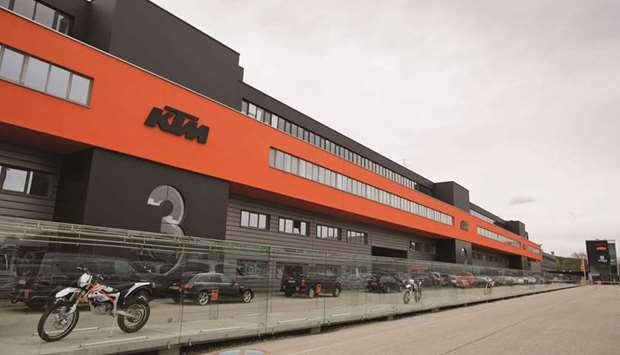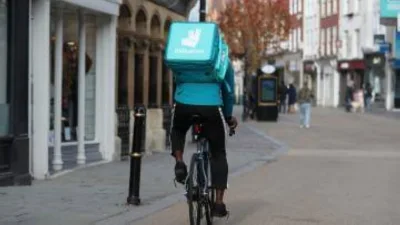European’s leading motorbike maker, KTM, booked record profits last year as it lifted sales and expanded its market share, according to preliminary figures obtained by AFP yesterday.
KTM, based in Mattighofen close to the German border, said its net profit climbed by 28% to €108mn ($124mn) in 2018 as unit sales jumped by 10% to 261,454 motorcycles.
Turnover edged up by 2% to €1.56bn.
And the group, whose brands include KTM and Husqvarna, said its market share grew to 11.7% from 8.9%.
KTM said it is targeting annual sales of 400,000 units by 2022, which would represent an increase of 50% over the 2018 figures, with growth coming from emerging economies such as India.
KTM acquired the Husqvarna brand from German rival BMW in 2013.
It produces the majority of its motorbikes at the plant in Mattighofen and exports more than 90% of its output.
The group, which employs a workforce of 4,300, is listed on the Vienna stock exchange, but remains 62% owned by its chief executive, Stefan Pierer.
Verizon
Verizon Communications Inc yesterday gave full-year 2019 profit guidance that disappointed investors, and missed analysts’ fourth quarter revenue estimates, though it beat on profit.
The company forecast that adjusted earnings per share for this year would be similar to 2018, and that it expected low-single-digit percentage growth for total revenue for the full year.
Verizon chief financial officer Matt Ellis said during the earnings call with analysts that the company expects earnings per share growth to be reduced by 24 cents to 28 cents, due to a higher effective tax rate and increased interest expense.
Ellis said Verizon’s business was still strong enough to offset the “non-operational items” and balance out to the same earnings per share level from 2018.
Total operating revenue rose 1% to $34.28bn in the fourth quarter, missing the average analyst estimate of $34.44bn, according to Refinitiv data.
The company forecast an increase in 2019 capital spending to the range of $17bn to $18bn, including the expansion of the commercial launch of its 5G wireless technology, up from $16.7bn last year.
Verizon launched 5G home internet in four cities last October, and claimed to be the first to offer a commercial 5G product in the United States amid heated competition between major carriers.
Verizon, which has 118mn wireless customers, said it added a net 653,000 postpaid phone subscribers during the fourth quarter, beating the average estimate of 355,600, according to research firm FactSet.
Lockheed Martin
Lockheed Martin Corp, the Pentagon’s top weapons supplier, yesterday forecast 2019 profit below estimates and reported that quarterly margins slipped at the unit that makes the radar-evading F-35 fighter jet and C-130 transport plane.
But Lockheed and other US weapons makers sales are expected to benefit from stronger global demand for fighter jets and munitions and higher US defence budgets in fiscal 2020.
During the quarter, Lockheed’s order backlog grew 19% to $130.5bn from $109bn.
Operating margins at the aeronautics division, Lockheed’s biggest, fell to 10.6% in the fourth quarter from 11.6% a year earlier.
The company cited lower sales in the C-130 transport aircraft programme.
Operating margins measure how much profit a company makes on a dollar of sales.
Lockheed expects full-year profit to range between $19.15 and $19.45 per share, below the average analyst estimate of $19.55, according to IBES data from Refinitiv.
Sales at the company’s missiles and fire control business, which makes PAC-3 missiles for the Patriot missile defence system and the Terminal High Altitude Area Defence system (THAAD), designed to shoot down short-, medium-, and intermediate-range ballistic missiles, rose 22% to $2.4bn during the fourth quarter.
The company earned $4.39 per share from continuing operations, just short of estimates of $4.40 per share.
Net sales rose 4.1% to $14.41bn.
During the quarter Lockheed had an effective tax rate of 13.6% which gave it a full-year tax rate of 15.5% following corporate tax reform in the United States.
Pfizer
Pfizer Inc forecast 2019 profit and sales below Wall Street estimates yesterday as the company expects to take a blow from a stronger dollar and as well as the loss of patent on its blockbuster pain treatment Lyrica this year.
The drug maker, along with partner Eli Lilly & Co, also reported data from a late-stage trial of painkiller tanezumab, that some analysts said could raise safety concerns.
Pfizer has outlined tanezumab, an experimental non-opioid drug for osteoarthritis pain, as one of its blockbuster drugs it intends to win approval for within five years.
Credit Suisse analyst Vamil Divan said the 2019 forecast, along with the data on tanezumab that will likely not ease any outstanding safety concerns on the drug, will lead to some pressure on Pfizer shares.
To counter revenue loss from generic competition to Lyrica, the largest US drugmaker has been investing heavily in its portfolio of cancer treatments and expects to gain approval for a new heart drug later this year.
The drug maker’s robust pipeline is seen by analysts as key to helping it ride out upcoming patent expirations and fighting increased competition from cheaper generics.
In the quarter, sales of breast cancer drug Ibrance rose 58% to $1.13bn, helped by demand in Europe, but came in slightly below the consensus estimate of $1.16bn, according to Credit Suisse.
In the fourth quarter, Lyrica brought in quarterly sales of $1.32bn, compared with a consensus estimate of $1.21bn.
The company earned 64 cents per share excluding items, just above the average analyst estimate of 63 cents per share.
Revenue rose about 2% to $13.98bn, also beating the estimate of $13.90bn.
Pfizer forecast 2019 adjusted earnings of $2.82 to $2.92 per share and revenue of $52bn to $54bn.
The outlook includes a $2.6bn hit from patent expirations and about $1bn from forex losses, the company said.
Analysts on average were expecting earnings of $3.04 per share and revenue of $54.25bn.
Siemens Gamesa
Wind turbine maker Siemens Gamesa forecast better profitability and said prices were stabilising yesterday, sending its shares as much as 9% higher.
The company formed by a merger between Spain’s Gamesa and the wind power business of Siemens stuck to its guidance for an earnings before interest and tax (EBIT) margin of 7 to 8.5% for the full year.
Chief executive Marcus Tacke told analysts on a conference call he expects a stronger second half to the year, after the company said its EBIT margin for the October-December quarter fell to 6.1% from 6.3%.
Siemens Gamesa, which vies with Denmark’s Vestas to lead the global wind turbine sector, said revenue for the period rose to €2.26bn from €2.13bn a year earlier.
The company said profitability had been dragged down by pricing on a backlog of orders struck in 2018, a year in which they fell 9%, and a worse performance by its onshore unit.
Allergan
Allergan Plc yesterday forecast 2019 revenue below analysts’ estimates, as the company faces impending competition for its second-most important medicine, the eye drug Restasis.
Allergan has warned that profits will be hurt once generics of Restasis hit the market after a bid to protect that drug’s patents met regulatory scrutiny.
Sales of Restasis fell 17.7% to $341.6mn in the fourth quarter.
Excluding items, the company earned $4.29 per share, beating analysts’ expectations of $4.15 per share, according to Refinitiv data.
Net revenue fell to $4.1bn from $4.33bn.
The company forecast full-year 2019 revenue of $15bn-$15.3bn, compared with analysts’ estimates of $15.40bn.
SAP
German software giant SAP said yesterday it would slash 4,400 jobs in a billion-euro restructuring plan after profits stagnated in 2018, while insisting it was on track to grow revenues and earnings this year.
“We are talking about a completely voluntary programme,” chief financial officer Luka Mucic said.
The number of job cuts would be “slightly higher” than during a previous overhaul in 2015, he added, when the group shifted focus to “cloud” computing from traditional software.
“We are expecting 4,400 job cuts, more than the 3,000 in 2015 and we think that Germany and the US will be the most impacted,” spokesman Benjamin Nickel told AFP.
Under the new turnaround plan, executives plan to spend between €800mn and €950mn ($915-$1.1bn) on restructuring in 2019 “to further simplify company structures and processes”.
They aim to realise “a minor cost benefit” this year, before slashing annual outgoings by up to €850mn from 2020.
SAP’s restructuring announcement came as it reported net profit added just 1% last year to reach €4.1bn.
The group preferred to play up operating, or underlying profit that surged 17%, to €5.7bn, on revenues up 5.0% at €24.7bn.
The result “sets us up perfectly for continued strong profitable growth in 2019 and beyond,” Mucic said.
One area the group hopes will stoke the bottom line is so-called “experience management” after it recently snapped up Californian firm Qualtrics for $8bn.
Invented in the 1990s, the technique calls for collecting data on customers, employees, brands and products, aiming to sharpen firms’ understanding of how they are perceived.
In 2018, SAP continued its transformation away from traditional one-off sales of business software licenses to cloud computing, under which it charges customers a subscription fee to process data on the firm’s computers.
Revenue from cloud subscriptions and support grew 32% over the year, to almost €3.8bn.
Meanwhile software licenses and support revenue shrank 1%, although it remains a far bigger source of income for now at almost €15.8bn.
Across the whole group, SAP aims to increase revenue from its cloud and software activities to between 22.4 and €22.7bn in 2019 — up from 20.66bn booked last year under non-IFRS accounting standards, which exclude some costs.
Still in non-IFRS terms, the group aims for operating profit of 7.7 to €8.0bn this year, up from €7.16bn in 2018.
SAP stock rebounded were trading down 2.4% at 90.15 euros around 12:40 pm in Frankfurt (1140 GMT) — while remaining the worst performer on the DAX index of blue-chip shares.
Philips
Dutch electronics giant Philips said yesterday its 2018 headline earnings plunged more than 40%, reflecting the disposal of its lighting business, but underlying profit rose while sales were steady.
The company, which is focusing its business on medical equipment and services, said its full-year net profit was down 41.3% at €1.09bn ($1.25 billion) on sales of €18.12bn, up nearly two percent.
Philips said however that 2018 net profit on its continuing activities jumped more than 27% to €1.31bn.
“We achieved our objectives for the year,” company chief Frans van Houten said in a statement.
“While Philips continues to face global geopolitical challenges and market volatility, for which we are taking the necessary measures, we see an improvement in our performance dynamic,” Van Houten added.
The company reaffirmed its 2019 targets of a 4.0-6.0% increase in sales on a comparable basis, plus an improved operating margin.
Best known for the making light bulbs, electrical appliances and television sets, Philips has dropped these activities in face of fierce competition from Asia.
It focuses now more on high-end medical and health technology as well as household appliances.
The group, which sold its first light bulb a few years after it was founded in 1891, listed its Philips Lighting division, known as Signify, on the Amsterdam stock exchange in March last year.
Domino’s
Domino’s Pizza, Britain’s biggest pizza delivery firm, said yesterday it expects full-year underlying pretax profit at the lower end of a consensus range, despite selling a record number of pizzas on the Friday before Christmas.
Casual dining chains in Britain continue to face higher expenses from a rise in the national living wage and food costs amid a slowdown in consumer spending due to uncertainty about Britain’s impending exit from the European Union.
Domino’s Pizza, a franchise of US company Domino’s Pizza Inc, said it plans to invest in other European markets, but added that the move would hit overall profitability in the short term.
Sales in its international markets rose 1.6% on a constant currency basis during the fourth quarter.
“Our international businesses offer significant long term potential, but we have experienced growing pains this year, particularly in Norway, where we have faced business integration challenges,” chief executive officer David Wild said.
The company said it expects its international operations, which includes countries such as Germany and Luxembourg, to break even in 2019.
The popularity of the company’s cheeseburger pizza fuelled record sales of more than 535,000 pizzas, which equates to 12 every second, on the Friday before Christmas.
Sales at UK stores open for over a year rose 4.5% during the 13-week period ended December 30, as cash-conscious diners in the firm’s home market are increasingly ordering in through smartphones.
Underlying pretax profit was previously expected to be between 93.9mn pounds and 98.2mn pounds ($129.15mn — $123.50mn), the company said.
It reported underlying pretax profit of 96.2mn pounds in 2017.
Whirlpool
US home appliances maker Whirlpool Corp said on Monday its 2019 adjusted profit and revenue are likely to rise less than analysts’ expectations due to a higher tax bill, costs and a strong dollar, sending its shares down 6.5% after the bell.
Whirlpool has been grappling with high costs as a trade dispute between United States and China has made imported steel and aluminium more expensive, forcing it to raise prices for its washing machines and kitchen appliances.
The company said it expects about $300mn more in expenses due to higher import duty on raw materials used in its appliances.
A higher tax rate is also expected to reduce its full-year earnings by 30 cents per share, the company said.
Whirlpool’s disappointing forecasts follows weak guidance from industrial bellwether Caterpillar and chipmaker Nvidia, both of which blamed slowing demand from world’s No.2 economy, China.
The company said it expects 2019 adjusted profit to be in the range of $14 to $15 per share compared with analysts’ expectation of $15.99 and revenue of $20.3bn, below Wall Street estimate of $20.76bn, according to IBES data from Refinitiv.
The company said higher raw material costs and tariffs resulted in softer demand in North America, its biggest segment.
But still sales in the region grew about 7% to $3.10bn.
However, weak demand in Europe, Middle East and Africa pulled down its overall net sales by about 0.7% to $5.66bn, missing analyst average estimate of $5.76bn.
In October, the US manufacturer had said it would exit a number of loss-making businesses in Europe in a bid to restore profitability.
In a post-earnings presentation, the company said it expected “uncertain external environment and volatility to continue”.
The company’s fourth-quarter profit beat analysts’ estimates, boosted by higher margins in North America.
Excluding items, it earned $4.75 per share and beat the analyst average estimate of $4.23 per share.
Vale
Brazilian mining giant Vale lost more than $18bn of its value on Monday in a dramatic share plunge on the Sao Paulo stock exchange as investors reacted to the collapse of one of its dams that killed scores and left hundreds missing.
Vale, the world’s biggest iron ore miner, has seen its reputation severely tarnished by the deadly accident — the second involving a company-owned mine in the southeastern Brazilian state of Minas Gerais in just over three years.
The company announced it was suspending dividend payments to shareholders and performance-related bonuses to executives.
Brazilian authorities separately have frozen a total of 11bn reais — around $3bn — in Vale assets in anticipation of compensation it will likely have to fork out.
A tsunami of mineral-laced mud broke through a dam at an iron-ore mine owned by Vale near the town of Brumadinho on January 25.
The official toll from the disaster so far stands at 60 dead and 292 missing.
Vale said it had passed a structural safety inspection four months ago, which was confirmed by Tuev Sued, the German firm that carried it out.
Vale, headquartered in Rio de Janeiro, made $5.5bn in profits, on revenue of $34bn, in 2017, the last full-year results available.
That net result was 38% higher than the previous year, evidence of a bounce back after a sharp commodities slump in 2015 that forced the company into cost-cutting.
Harley-Davidson
Harley-Davidson Inc reported a lower-than-expected quarterly profit yesterday amid a prolonged struggle to revive demand for its bikes in the United States where sales dived yet again, sending its shares down over 6%.
The Milwaukee-based company reported an adjusted profit of $0.17 per share in the fourth quarter.
Analysts surveyed by Refinitiv, on average, expected the profit to come in at $0.28 per share.
Revenue from motorcycles and related products fell 8.7% to $955.6mn.
Retail sales in the United States, which accounts for more than half of the company’s sales, fell 10.1% in the fourth quarter ended December 31, more than the 8.3% decline expected by analysts.
Harley’s demographic challenges in the domestic market are well documented — core customers are growing older and outreach efforts to attract new and young riders have yet to show results.
To offset weak demand in the domestic market, it is trying to grow sales overseas.
However, those efforts have yet to bear fruits as sales in foreign markets fell 2.6% in the latest quarter from a year ago.
After missing its shipments guidance last year, Harley expects to ship up to 222,000 motorcycles globally this year, its lowest in eight years.
Analysts on average were expecting 2019 shipments of 228,190 motorcycles, according to research firm Consensus Metrix.
To woo the next generation of riders, the company is betting on the small but growing market for electric bikes.
Its LiveWire electric bike is now available for pre-order in the United States at a price of $29,799, with delivery expected this fall.
But with electric motorcycles available at around $10,000, along with a worsening outlook for the economy and rising interest rates, the bike might not be affordable for many riders.
While the pricing strategy is aimed at retaining Harley’s “premium” tag as well as preserving profit margins, analysts and some dealers reckon it is hurting sales.

Photo 2


